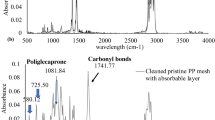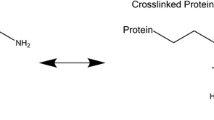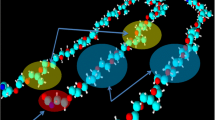Abstract
Background
Oxidative degradation by reactive oxygen species (ROS) from inflammation initiates cross-linking, depolymerization, and formation of a quasi-crystalline quality in polypropylene (PP) meshes that cause embrittlement (J Urol 188:1052, 2012). Embrittlement leads to change in tensile strength and is associated with post-operative complications that include pain, adhesion, dislodgment, and fragmentation.
Methods
A laboratory environment was constructed to study the relationship between concentration of ROS and change in tensile strength. Samples of Ethicon Ultrapro© PP mesh were exposed to 1 mM, 0.1 M, or 1 M hydrogen peroxide solutions for 6 months and were subjected to load displacement tensile testing (LDTT) and compared to unexposed (0 M) meshes of the same brand.
Results
Load at failure and elongation to failure after LDTT were determined with 95 % confidence interval. For unexposed (0 M) samples, tensile strength was 28.0 ± 2.4 lbf and elongation to failure was 2.0 ± 0.3 in. For samples exposed to 1 mM, tensile strength was 19.2 ± 1.1 lbf and the elongation to failure was 2.0 ± 0.1 in. For samples exposed to 0.1 M, tensile strength was 19.3 ± 1.6 lbf and elongation to failure was 1.9 ± 0.1 in. For samples exposed to 1 M, tensile strength was 20.7 ± 1.2 lbf and elongation to failure was 0.47 ± 0.02 in.
Conclusion
The results demonstrated that a 6-month exposure to a physiologic range of ROS (1 mM) decreased tensile strength of PP mesh by 31 %. 1 mM and 0.1 M samples behaved similarly demonstrating properties of a quasi-crystalline nature. 1 M samples displayed qualities of extreme embrittlement. Scanning electron microscopy (SEM) observed fiber changes. 1 M meshes had features of brittle materials. Knowledge of changes in physical properties of PP meshes is useful for considerations for the development of a more biocompatible surgical mesh.






Similar content being viewed by others
References
Amid PK (1997) Classifications of biomaterials and their related complications in abdominal wall hernia surgery. Hernia 1:15–21
Bloch B (1984) International standards for surgical implants. Ann R Coll Surg Engl 66:369–371
Costello CR, Bachman SL, Ramshaw BJ, Grant SA (2007) Materials characterization of explanted polypropylene hernia meshes. J Biomed Mater Res 83:44–49
Davis JR (2003) Handbook of materials for medical devices. ASM International, Materials Park, OH
Korotkova E, Misini B, Dorozhko EV, Bukkel MV, Plotnokov EV, Linert W (2011) Study of OH radicals in human serum blood of healthy individuals and those with pathological schizophrenia. Int J Mol Sci 12:401–410
Sheftel VO (1990) Toxic properties of polymers and additives. Rapra Technology, Shawbury, UK
Sternshuss G, Ostergard D, Patel H (2012) Post-implantation alteration of polypropylene in the human. J Urol 188:1052
Usher FC, Cogan JE, Lowry TI (1960) A new technique for the repair of inguinal and incisional hernias. Arch Surg 81:847–854
Weiss SJ (1989) Tissue destruction by neutrophils. N Engl J Med 320:365–376
Williams DF (1982) Review: biodegradation of surgical polymers. J Mater Sci 17:1233–1246
Acknowledgments
Mesh used in this experiment was donated by Ethicon.
Author information
Authors and Affiliations
Corresponding author
Ethics declarations
Disclosures
Jean Kurtz, Ben Rael, Jesus Lerma, Catherine Wright, Tariq Khraishi, and Edward D. Auyang have no conflicts of interest or financial ties to disclose.
Rights and permissions
About this article
Cite this article
Kurtz, J., Rael, B., Lerma, J. et al. Effects of reactive oxygen species on the physical properties of polypropylene surgical mesh at various concentrations: a model for inflammatory reaction as a cause for mesh embrittlement and failure. Surg Endosc 30, 3250–3255 (2016). https://doi.org/10.1007/s00464-015-4646-3
Received:
Accepted:
Published:
Issue Date:
DOI: https://doi.org/10.1007/s00464-015-4646-3




